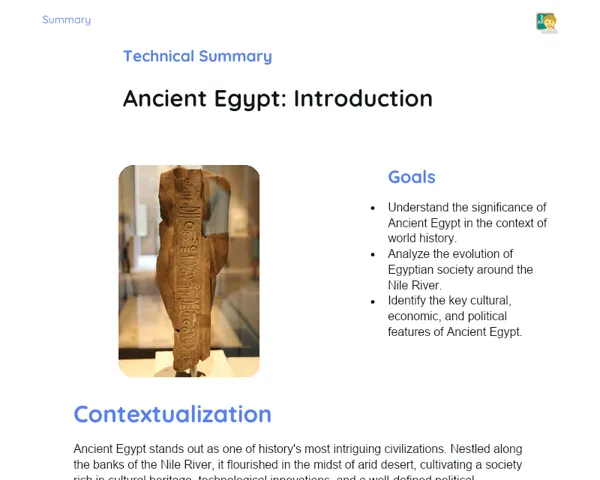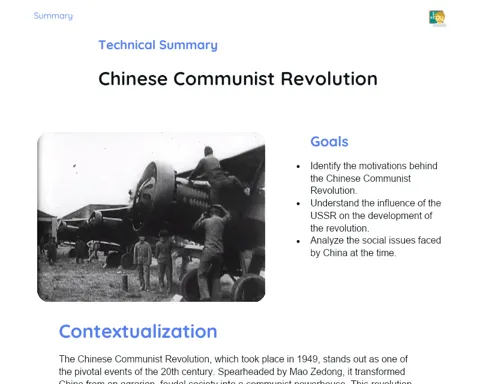Summary Tradisional | First Industrial Revolution: Review
Contextualization
The First Industrial Revolution was a pivotal chapter in human history, taking place in England from the late 18th century to the early 19th century. This era marked the shift from an agrarian and handcrafted economy to one that was industrialized and mechanized. Key technological advancements, including the steam engine enhanced by James Watt, played a vital role in this change, enabling various industries to adopt machinery, which in turn significantly boosted productivity. The abundance of natural resources like coal and iron, along with the growth of global trade, were also critical to this industrial growth.
With industrialization came a profound transformation in how labor was organized. The factory system supplanted traditional artisanal work, leading to the division of labor and large-scale production. This shift created a working class that often endured long hours under conditions that were frequently unhealthy and hazardous. The swift urbanization that followed resulted in the chaotic expansion of industrial cities, which brought challenges such as overcrowding, inadequate infrastructure, and pollution. However, these cities also emerged as hubs of innovation and trade, playing a pivotal role in the global economy.
To Remember!
Technological Innovations
The First Industrial Revolution was distinguished by a series of technological breakthroughs that fundamentally changed production methods. Among the most impactful was the steam engine, refined by James Watt. This invention enabled various industries to mechanize, substituting human and animal power with steam-generated energy, greatly enhancing productivity and efficiency.
Another significant advancement was the mechanization of the textile sector. Innovations like the Spinning Jenny, the power loom, and the Water Frame transformed textile manufacturing, allowing for mass production that was unachievable with earlier techniques. These machines not only ramped up output but also lowered the costs of textile goods, making them accessible to a wider audience.
The steam locomotive, created by George Stephenson, also transformed the landscape. It facilitated the swift and efficient movement of goods and people, linking distant regions and boosting trade and mobility. This development not only revolutionized logistics and commerce but also shaped the infrastructure of industrialized nations.
-
Steam engine refined by James Watt
-
Mechanization of the textile sector
-
Steam locomotive created by George Stephenson
Changes in the Organization of Work
The First Industrial Revolution drastically altered how work was organized. Prior to this period, production was largely characterized by artisanal labor conducted in small workshops or at home. With the advent of industrialization, this structure was replaced by the factory system, where large-scale production and labor division became standard.
In the factory environment, each worker was tasked with a specific step in the production process, boosting efficiency and output. However, this shift presented substantial challenges. Workers endured long hours in often unhealthy and perilous conditions. Strict discipline and a demanding work regimen were hallmarks of factories during this time.
The rise of a working class was another significant outcome. This new social class largely comprised of wage-dependent laborers faced daunting challenges. Poor working conditions sparked the emergence of social movements and labor unions, which campaigned for improved working conditions and labor rights.
-
Transition from artisanal work to the factory system
-
Division of labor and large-scale production
-
Rise of the working class
Social and Economic Impact
The Industrial Revolution led to significant social and economic consequences. One of the most visible effects was urbanization, as industrial cities expanded rapidly, attracting workers from rural areas seeking factory employment. This often disorderly growth caused overcrowding, inadequate infrastructure, and poor living conditions.
Economically, the Industrial Revolution propelled both the production and consumption of goods. Mass production led to reduced product costs, making them affordable for a broader demographic. This period also marked the emergence of a new industrial middle class made up of entrepreneurs and skilled workers who benefitted from this economic progress.
Conversely, the working class faced numerous challenges. Long hours, meager wages, and unsatisfactory working conditions led to the rise of social movements advocating for better living and working conditions. These movements were crucial in securing labor rights and gradually improving working conditions.
-
Urbanization and city growth
-
Rise in production and consumption
-
Emergence of a new industrial middle class
-
Social movements advocating for better conditions
Urban Growth
The swift expansion of industrial cities was one of the most striking outcomes of the First Industrial Revolution. With industry growth, a plethora of workers migrated from rural to urban areas in search of employment. This urbanization process often unfolded chaotically, without the necessary infrastructure to support the surging population.
Industrial cities grappled with numerous challenges, such as overcrowding, inadequate access to basic amenities like drinking water and sanitation, and deteriorating living conditions. Air and water pollution became pressing issues caused by factory emissions and untreated waste. These conditions led to high mortality rates and widespread diseases among city dwellers.
Nonetheless, these urban areas also evolved into centers of innovation and commerce. The dense concentration of people and resources fostered the development of new technologies and ideas. Industrial cities became key economic drivers, playing a crucial role in the global economy while disseminating technological and cultural advancements.
-
Rapid and chaotic urban growth
-
Overcrowding and infrastructure deficits
-
Pollution and poor living conditions
-
Cities as hubs for innovation and commerce
Key Terms
-
First Industrial Revolution: A historical phase marked by crucial technological innovations and sweeping social and economic changes, occurring in England from the late 18th century to the early 19th century.
-
Steam engine: An invention enhanced by James Watt that utilized steam for generating energy, revolutionizing industrial manufacturing.
-
Factory system: A novel work organization model that replaced traditional artisanal labor, featuring large-scale production and labor division.
-
Urbanization: The swift and often chaotic expansion of industrial cities, driven by the migration of rural workers seeking employment in factories.
-
Working class: A new social stratum formed of workers dependent on wages for survival, emerging in tandem with industrialization.
-
Social movements: Collectives and organizations advocating for improved working conditions and labor rights for workers.
Important Conclusions
The First Industrial Revolution stands as a pivotal moment in history, introducing technological innovations that transformed both production methods and daily life. Innovations like James Watt's improved steam engine and the mechanization of textiles revolutionized industrial efficiency, while the steam locomotive enhanced the transportation of goods and people, fostering global trade.
The labor landscape experienced significant upheaval with the shift from artisanal crafts to factory-based production. While this new large-scale production model brought about greater efficiency, it also led to poor working conditions for the burgeoning working class. This backdrop incited the rise of social movements that tirelessly campaigned for improved rights and working conditions.
The social and economic repercussions of the Industrial Revolution were profound, with rapid urban growth presenting both challenges and prospects. Cities transformed into centers of innovation and trade, despite grappling with issues like overcrowding and lack of infrastructure. Understanding this era is essential to grasp the roots of many modern practices and technologies, as well as the current urban and societal difficulties we face.
Study Tips
-
Go over the main discussion points from class and take thorough notes. This will reinforce the content and highlight areas needing further study.
-
Explore additional books and articles regarding the First Industrial Revolution to broaden your understanding. Recommended readings include works by notable historians and academic articles available in libraries and online.
-
Engage in group discussions or online forums focused on the Industrial Revolution. Exchanging ideas and perspectives can deepen your understanding and provide fresh insights into the topic.



